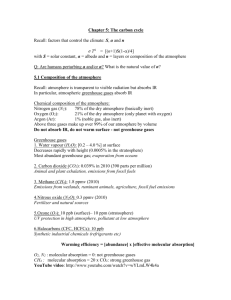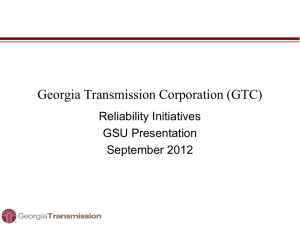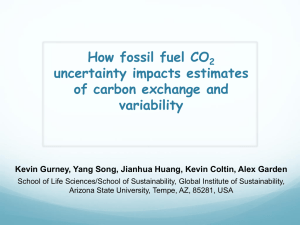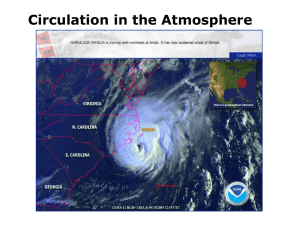Numbers for Carbon Cycle Applet
advertisement
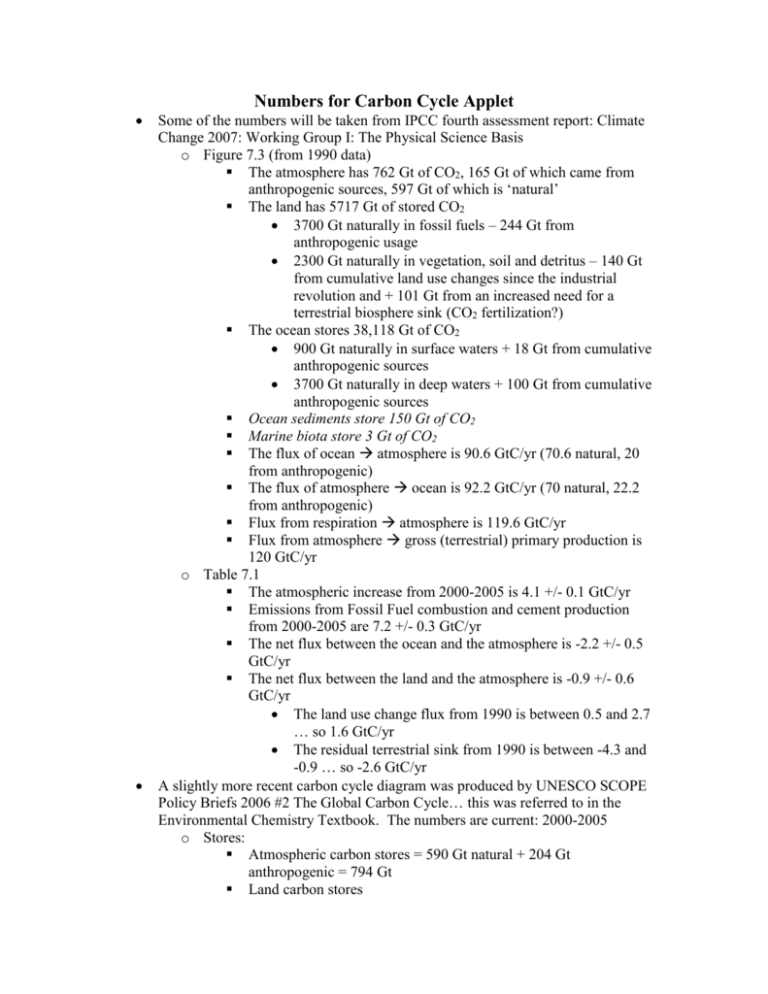
Numbers for Carbon Cycle Applet Some of the numbers will be taken from IPCC fourth assessment report: Climate Change 2007: Working Group I: The Physical Science Basis o Figure 7.3 (from 1990 data) The atmosphere has 762 Gt of CO2, 165 Gt of which came from anthropogenic sources, 597 Gt of which is ‘natural’ The land has 5717 Gt of stored CO2 3700 Gt naturally in fossil fuels – 244 Gt from anthropogenic usage 2300 Gt naturally in vegetation, soil and detritus – 140 Gt from cumulative land use changes since the industrial revolution and + 101 Gt from an increased need for a terrestrial biosphere sink (CO2 fertilization?) The ocean stores 38,118 Gt of CO2 900 Gt naturally in surface waters + 18 Gt from cumulative anthropogenic sources 3700 Gt naturally in deep waters + 100 Gt from cumulative anthropogenic sources Ocean sediments store 150 Gt of CO2 Marine biota store 3 Gt of CO2 The flux of ocean atmosphere is 90.6 GtC/yr (70.6 natural, 20 from anthropogenic) The flux of atmosphere ocean is 92.2 GtC/yr (70 natural, 22.2 from anthropogenic) Flux from respiration atmosphere is 119.6 GtC/yr Flux from atmosphere gross (terrestrial) primary production is 120 GtC/yr o Table 7.1 The atmospheric increase from 2000-2005 is 4.1 +/- 0.1 GtC/yr Emissions from Fossil Fuel combustion and cement production from 2000-2005 are 7.2 +/- 0.3 GtC/yr The net flux between the ocean and the atmosphere is -2.2 +/- 0.5 GtC/yr The net flux between the land and the atmosphere is -0.9 +/- 0.6 GtC/yr The land use change flux from 1990 is between 0.5 and 2.7 … so 1.6 GtC/yr The residual terrestrial sink from 1990 is between -4.3 and -0.9 … so -2.6 GtC/yr A slightly more recent carbon cycle diagram was produced by UNESCO SCOPE Policy Briefs 2006 #2 The Global Carbon Cycle… this was referred to in the Environmental Chemistry Textbook. The numbers are current: 2000-2005 o Stores: Atmospheric carbon stores = 590 Gt natural + 204 Gt anthropogenic = 794 Gt Land carbon stores >6000 Gt fossil fuels – 302 Gt used by people 6850 Gt stored in plants and soils – 162 Gt used by people + 161 added terrestrial biosphere increase Ocean stores are 38000 Gt + 135 Gt from anthropogenic changes o Fluxes Flux of ocean atmosphere is 90.6 GtC/yr (70.6 natural, 20 from anthropogenic) The flux of atmosphere ocean is 92.2 GtC/yr (70 natural, 22.2 from anthropogenic) Flux from oceans sediments is 0.5 GtC/yr Respiration & fires: 55.5 GtC/yr Primary production (photosynthesis): 57 GtC/yr Anthropogenic land use: Use = 1.5 GtC/yr (deforestation, land use changes) Sinks = 2.4 GtC/yr (forest/crop growth and soil storage) Fossil fuel & cement emissions: 7.2 GtC/yr Citation: UNESCO-SCOPE. 2006.The Global Carbon Cycle.UNESCO-SCOPE Policy BriefsOctober 2006 – No. 2.UNESCO-SCOPE, Paris The data from UNESCO is more recent and more consistent with the data found in both the Chemistry in Context and Environmental Chemistry textbooks. Even more recent is the UNESCO SCOPE policy briefs from 2009 o Fluxes (2000-2008) There is a net of 4 GtC/yr into the atmosphere Fossil fuel & cement emissions from 2008 are 8.7 Gt C/yr Land use flux = 1.4 GtC/yr Land sink flux = 2.7 GtC/yr Ocean sink flux = 2.3 GtC/yr http://unesdoc.unesco.org/images/0018/001861/186137e.pdf o There are also some interesting vulnerable carbon pools: o Land: Permafrost ....................................(900 Gt C) High-latitude peatlands ........(400 Gt C) Tropical peatlands...................... (100 Gt C) Vegetation subject to fire and/or deforestation .............. (650 Gt C) o Ocean: Methane Hydrates .........(10,000 Gt C) Solubility Pump ..................(2,700 Gt C) Biological Pump ................ (3,300 Gt C) An excel sheet of CO2 emissions from 1750 to 2006 are taken from CDIAC’s website: http://cdiac.ornl.gov/ftp/ndp030/global.1751_2006.ems Objectives: Students should understand the role that various factors play in the carbon cycle Students will come to know the various sources and sinks in the carbon cycle, the relative fluxes that they have to and from the atmosphere, and the natural balance that there is in between these sources o It will become apparent that much of the carbon flow in the carbon cycle happens naturally, from the exchange between producers and consumers, various levels in the ocean and in the soil or biosphere Students will be able to change various anthropogenic carbon emissions in the applet and see what kind of influence a small change in carbon emissions may have to upset the equilibrium o While carbon sinks can take up some of the human emissions, reequilibriating the system, about half of the carbon emissions will be released into the atmosphere Students will be given a sense of the time scale over which these changes can take place and how long it may take for carbon in the atmosphere to be sequestered into permanent sinks Give students a sense of what a GtC or PgC is How this will occur: 7-box model of the carbon cycle A place to input various anthropogenic emissions An advanced editor where the fluxes and stores can be changed (with a reset button) Visual representation of: o Atmosphere o Surface ocean o Intermediate ocean o Deep ocean o Sediments o Biosphere o Soil o Land use o Fossil fuel & cement emissions o Fossil fuel stores? Numbers in GtC or PgC showing how much each CO2 is present in each sector and how much is coming out of each… possibly a rollover function here An “About” button or something to explain GtC or PgC… and how it is related to ppm Graph of CO2 concentrations (in ppm?) Output data A play or forward button to show the changes each year, starting with either the current year, or a pre-industrial year (adjustable by the user) o This means that we must have data going back this far o The data, if possible, should be able to go on indefinitely

